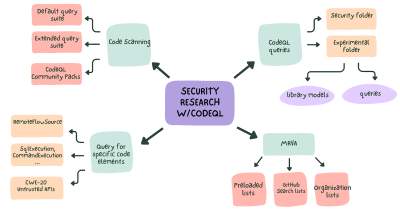
Attacking browser extensions
Learn about browser extension security and secure your extensions with the help of CodeQL.

Resources for securing your supply chain, building more secure applications, and staying up-to-date with the latest vulnerability research. Get comprehensive insights into the latest security trends—and news from the GitHub Security Lab. You can also check out our documentation on code security on GitHub to find out how to keep your code and applications safe.

Learn about browser extension security and secure your extensions with the help of CodeQL.


Learn about a community-developed framework for how to think about this problem holistically and how to use GitHub, particularly, to improve the security in the second half of your software supply chain.

For this year’s Cybersecurity Awareness Month, GitHub’s Bug Bounty team is excited to offer some additional incentives to security researchers!

In this post, I’ll exploit CVE-2024-5830, a type confusion in Chrome that allows remote code execution (RCE) in the renderer sandbox of Chrome by a single visit to a malicious site.

As we wrap up Cybersecurity Awareness Month, the GitHub Bug Bounty team is excited to feature another spotlight on a talented security researcher who participates in the GitHub Security Bug Bounty Program—@adrianoapj!

Vulnerability data has grown in volume and complexity over the past decade, but open source and programs like the Github Security Lab have helped supply chain security keep pace.

For this year’s Cybersecurity Awareness Month, the GitHub Bug Bounty team is excited to feature another spotlight on a talented security researcher who participates in the GitHub Security Bug Bounty Program—@imrerad!

Introducing the generally available capability of GitHub Artifact Attestations to secure your cloud-native supply chain packages and images.

In this blog post, we’ll explain how we discovered three critical vulnerabilities in Kafka UI and how they can be exploited.

In this post, I’ll exploit CVE-2024-3833, an object corruption bug in v8, the Javascript engine of Chrome, that allows remote code execution (RCE) in the renderer sandbox of Chrome by a single visit to a malicious site.

Can an attacker execute arbitrary commands on a remote server just by sending JSON? Yes, if the running code contains unsafe deserialization vulnerabilities. But how is that possible? In this blog post, we’ll describe how unsafe deserialization vulnerabilities work and how you can detect them in Ruby projects.

Let’s take a look at 10 key moments from the first decade of the GitHub Security Bug Bounty program.

GitHub is working with the OSS community to bring new supply chain security capabilities to the platform.

Learn how to use CodeQL for security research and improve your security research workflow.

We’ve dramatically increased 2FA adoption on GitHub as part of our responsibility to make the software ecosystem more secure. Read on to learn how we secured millions of developers and why we’re urging more organizations to join us in these efforts.

This blog post is an in-depth walkthrough on how we perform security research leveraging GitHub features, including code scanning, CodeQL, and Codespaces.

In this post, I’ll look at CVE-2023-6241, a vulnerability in the Arm Mali GPU that allows a malicious app to gain arbitrary kernel code execution and root on an Android phone. I’ll show how this vulnerability can be exploited even when Memory Tagging Extension (MTE), a powerful mitigation, is enabled on the device.

Repo-jacking is a specific type of supply chain attack. This blog post explains what it is, what the risk is, and what you can do to stay safe.

In practice, shifting left has been more about shifting the burden rather than the ability. But AI is bringing its promise closer to reality. Here’s how.
Build what’s next on GitHub, the place for anyone from anywhere to build anything.
Get tickets to the 10th anniversary of our global developer event on AI, DevEx, and security.